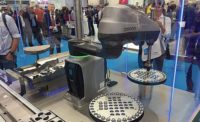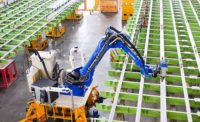More than 20,000 manufacturing professionals saw the newest robots, vision systems and motion control technologies during the 2019 Automate show and conference, which was held April 8-11 at McCormick Place in Chicago.
The biennial event hosted more than 500 exhibitors. Cartesian, SCARA, six-axis and delta robots; mobile robots; collaborative robots; grippers; tool changers; vision cameras; optics and lighting; motors; drives; and software were just some of the technologies that could be seen on the show floor.
Live demos and interactive exhibits featured:
- Integrated systems for unloading trucks and tending machines.
- Robotic laser welding and assembly equipment.
- Human-machine interaction for smart, flexible manufacturing.
- 3D machine vision for inspection and assembly.
- Artificial intelligence, machine learning and cloud robotics.
More than 120 conference sessions covered such topics as artificial intelligence, the Industrial Internet of Things, collaborative robots, smart manufacturing, 3D vision, and motion control. Free keynote presentations covered blockchain technology, the gender gap in manufacturing, and a self-made billionaire’s keys to business success. Industry professionals were eligible to earn vision and motion control certifications by participating in specific tracks.
“Automation and robotics are rapidly transforming workflow in areas such as warehousing and distribution, electronics assembly, automotive, and food and beverage, resulting in significant growth and not just for large, multinational companies,” says Jeff Burnstein, president of the Association for Advancing Automation, the show’s organizer. “We see strong growth within small and medium-sized companies, many of whom are attending Automate this year to learn how the latest innovations can solve their real-world challenges and help them be more competitive on a global scale.”
A key feature of the event was the Integrated Solutions Center, where systems integrators showcased live demos and interactive displays of robotics, vision and automation applications. This was especially helpful for new users of automation who wanted to learn about technologies available to help their businesses.
The next Automate show will take place May 17-20, 2021, at Cobo Center in Detroit.
“To continue our rapid growth, and better meet the needs of our exhibitors…we’ve decided that now is the right time to move Automate to its own location—and Detroit is an ideal fit,” says Burnstein. “Detroit is turning into the next major technology hub in the United States. This is an exciting change for us and our exhibitors, allowing Automate to expand in size and technology scope as the automation industry continues its steady growth.”
The following are some of the new technologies on display at the event.
Zero Downtime Robots
FANUC America demonstrated a variety of smart, connected Industrial IoT manufacturing technologies, including the FANUC Intelligent Edge Link and Drive (FIELD) system and Zero Down Time (ZDT) on ROBOT-LINKi.
The FIELD system offers engineers an open platform that collects machine data and monitors the operating status of their manufacturing equipment in real time. Third-party application developers can create and sell FIELD applications that improve equipment efficiency, production throughput and process quality using an industrial application program interface to access the data and perform analytics.
ZDT on ROBOT-LINKi is predictive analytics software for manufacturers that purchase FANUC robots. Available in cloud-based or on-premises versions, ZDT offers predictive analytics that can prevent unexpected downtime by identifying component failures in advance The software also recommends proper intervals for routine equipment maintenance activities. This allows plant managers to schedule regular production downtime for maintenance and mechanical hardware replacement rather than lose valuable time and money performing unscheduled repairs or maintenance.
Plant managers can monitor the manufacturing process using a web portal and have a clear picture of device health, equipment utilization and energy consumption. ZDT data can also help manufacturers reduce overall life cycle costs.
Nearly 20,000 robots in industry are operating with ZDT’s cloud-based software. Since its introduction, FANUC estimates that ZDT has saved customers over 2,200 hours of unexpected production interruptions, which equates to more than $67 million.
Festo’s Adaptive Gripper
Festo Corp.’s new DHEF adaptive gripper offers maximum flexibility while requiring minimum engineering. The adaptive gripper can hold a range of shapes, unaligned objects, and several objects at once. The gripper is also suitable for human-machine interaction.
The gripper’s design was inspired by the chameleon. This lizard uses its tongue to catch different insects by covering the target and securely enclosing it. The DHEF gripper uses this principle to grip the widest range of objects in a form-fitting manner. Using its elastic silicone cap, it can even pick up several objects in a single gripping process and put them down together, without the need for a manual conversion.
The gripper consists of a double-acting cylinder. One chamber is filled with compressed air, while the second one is permanently filled with water. This second chamber is fitted with elastic silicone molding, which equates to the chameleon’s tongue. The volume of the two chambers is designed so that the deformation of the silicone part is compensated. The piston, which closely separates the two chambers from each other, is fastened with a thin rod on the inside of the silicone cap.
During the gripping procedure, a handling system guides the gripper across the object so that it touches the article with its silicone cap. The top pressurized chamber is then vented. The piston moves upwards by means of a spring support, and the water-filled silicone part pulls itself inwards. Simultaneously, the handling system guides the gripper further across the object. In doing so, the silicone cap wraps itself around the object to be gripped, which can be of any shape, resulting in a tight form fit. The elastic silicone allows a precise adaptation to a wide range of different geometries. The high static friction of the material generates a strong holding force.
When holding an object, the gripper can move at a maximum speed of 120 millimeters per second. It can grip objects ranging from 12 to 38 millimeters in diameter.
Small-Parts Assembly
ABB Inc. demonstrated a small-parts handling and assembly operation at its booth. The demo featured ABB’s new Single-Arm YuMi, the IRB 910INV invert-mount SCARA, and the six-axis IRB 1100, all driven by the company’s new OmniCore Controller.
The sequence began with the Single-Arm YuMi placing a USB flash drive on a rail conveyor, where it is subsequently handled by the SCARA and the IRB 1100. The operation involves carefully inserting the drive into a duplicator, where materials specifically selected by an individual visitor to the ABB booth are loaded onto the drive. While the drive is in the duplicator, the two robots erect and stage a gift box, and, once completed, the loaded drive and several mints are placed into the box, which is then sealed and given to the visitor.
The demo highlights how new traditional or collaborative applications can be easily integrated into existing production or confined spaces, which is an important benefit for manufacturers seeking to squeeze more productivity or greater flexibility out of their current lines.
The Single-Arm YuMi is ABB’s most agile and compact collaborative robot. It is designed to fit easily into existing lines to increase productivity while working safely alongside people. The single-arm YuMi provides manufacturers of all sizes added flexibility and scalability to meet the challenges of high-mix, low-volume production in shorter cycles. It can be mounted on floors, tables, walls or ceilings, and is easy to program.
The single arm YuMi can work on its own, or it can be combined with ABB’s original dual-arm YuMi to create applications with three, five or more axes of motion.
The IRB 1100 is ABB’s smallest and lightest six-axis robot. It was designed to meet the unique challenges of semiconductor, pharmaceutical and electronics manufacturers, which need to handle small and often delicate parts while working at speed and maintaining both high productivity and quality.
The robot is 35 percent faster, 10 percent smaller and 20 percent lighter than ABB’s previous small robot. It is equipped with advanced motion control capabilities, making it ideal for supporting rapid assembly, pick and place, and material handling applications.
By mounting the IRB 910INV on the ceiling, manufacturers can increase the space efficiency and flexibility of assembly cells and do more complex tasks even in confined spaces. Being mounted on the ceiling also allows the robot to collaborate with other robots and machines simultaneously in the same footprint.
The new OmniCore family of robot controllers is designed for maximum performance and reliability in 24/7 factories making products with increasingly shorter lifecycles. The new controller features a 50 percent smaller footprint for maximum installation flexibility and floor space utilization. It features easy connection ports to many fieldbus protocols and force control systems.
The controller’s high path accuracy increases throughput and decreases cycle times, whether manufacturers need standardized motion control or more tailored solutions. In addition, ABB’s Ability Connected Services and SafeMove2 safety software are all built-in as standard.
Omron’s New Cobot
Omron Automation Americas displayed its new TM Series collaborative robot. With built-in vision and a user-friendly, plug-and-play programming interface, this highly transportable robot complies with safety requirements for human-robot collaboration specified in ISO 10218-1 and ISO/TS 15066. It can be easily trained to perform almost any repetitive task in any location thanks to a manual teaching function that allows operators to teach the robot with hand-guidance without the need for software.
Installation and setup times for the TM Series are shorter than for traditional industrial robots, thanks to a flowchart-based programming interface and intuitive teaching. No prior robot programming experience is necessary.
An integrated on-arm vision system further reduces setup time. The robot comes with built-in vision and integrated lighting for capturing images with a wide viewing angle. Image sensing functions include pattern matching, bar code reading and color identification.
The robot is geared towards manufacturers seeking to boost production and reduce employee fatigue by automating repetitive tasks such as machine tending, loading and unloading, assembly, screwdriving, gluing, testing or soldering.






